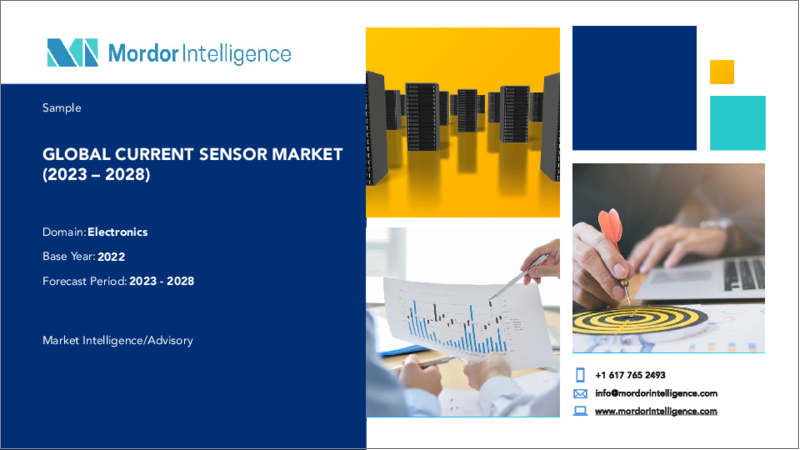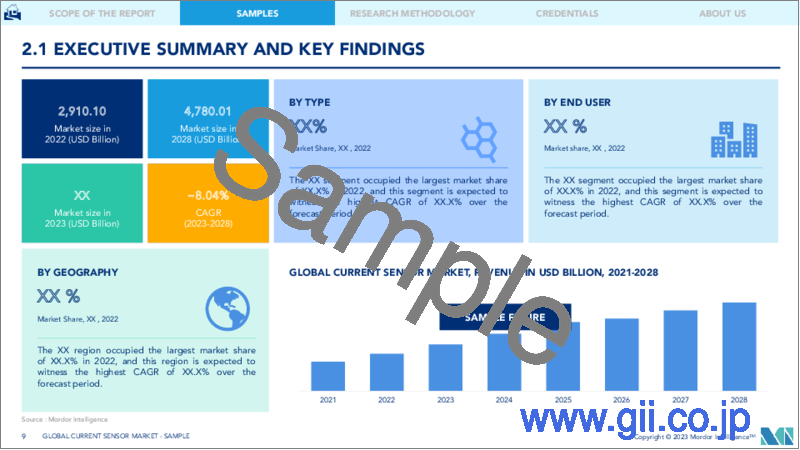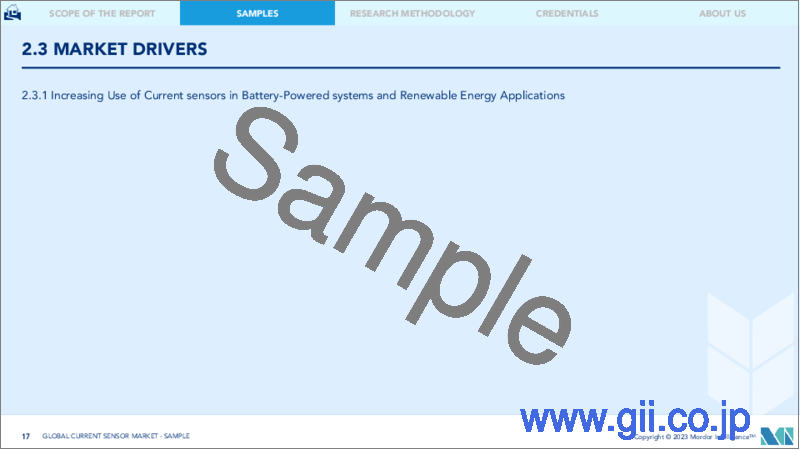|
|
市場調査レポート
商品コード
1190502
電流センサー市場- 成長、動向、予測(2023年~2028年)Current Sensor Market - Growth, Trends, and Forecasts (2023 - 2028) |
||||||
|
● お客様のご希望に応じて、既存データの加工や未掲載情報(例:国別セグメント)の追加などの対応が可能です。 詳細はお問い合わせください。 |
|||||||
| 電流センサー市場- 成長、動向、予測(2023年~2028年) |
|
出版日: 2023年01月18日
発行: Mordor Intelligence
ページ情報: 英文 120 Pages
納期: 2~3営業日
|
- 全表示
- 概要
- 目次
電流センサー市場は、予測期間中にCAGR8%で成長すると予測されています。
バッテリー駆動のアプリケーションや再生可能エネルギーアプリケーションの利用が急速に増加していることが、市場を牽引しています。スマートフォンやタブレットなどの携帯機器には、より小さなフォームファクターと低い消費電力率が求められます。電池の残量を予測し、過電流状態から回路やLi+電池を保護するための高精度かつ超低消費電力のソリューションとして、電流センサーの要件は高くなっています。電池駆動のアプリケーションでは、一般的にオープンループセンサーが使用されます。クローズドループセンサよりも消費電力が少なく、過負荷への耐性に優れています。
主なハイライト
- 近年、産業、自動車、商業、通信の各分野において、低コストで高精度、かつ小型の電流センサーに対する需要が高まっています。新しい設計コンセプトと先進技術の体系的な活用により、ICの性能をさらに向上させることが可能になりました。また、電源保護などの付加機能を同じ電流センサーICに統合することで、新しい製品アプローチへの道も開かれています。
- バッテリー駆動や再生可能エネルギーのアプリケーションの増加が市場を牽引しています。スマートフォンやタブレットなどの携帯機器には、小型化と低消費電力化が求められています。電流センサーは、電池残量の推定や、回路とLi+電池を過電流状態から保護するために、高精度かつ超低消費電力のソリューションを実現するために使用されています。
- スマートフォンの普及が進むことで、予測期間中に電流センサーの需要が高まると予想されます。例えば、エリクソンによると、2021年の世界のスマートフォンユーザー数は62億5,900万人であり、2027年には76億9,000万人に達すると予測されています。
- さらに、世界のエネルギー需要に対する懸念の高まりや環境意識の全体的な高まりにより、パワーエレクトロニクス・アプリケーションの設計者は、効率性の向上を常に迫られています。スマートグリッド、グリッド連系太陽光発電(PV)、その他のグリッド連系再生可能エネルギーシステムの出現により、高効率のパワーインバータの成長が求められています。国際エネルギー機関の「2050年ネットゼロエミッションシナリオ」によると、2030年には電気自動車が3億台普及し、新車販売台数の60%以上を占めるとされています(2020年はわずか4.6%)。EVやHEVに電流センサーが広く使用されるため、自動車エンドユーザーは今後も電流センサー市場成長の有意な要因の1つであると予測されます。
- IoTやIIoTの大規模な商用化が市場を後押ししています。エリクソンによると、セルラーIoTの接続数は2023年に35億に達すると予想されています。従来の製造業がデジタル変革を遂げる中、IoTはインテリジェントコネクティビティの次の産業革命に拍車をかけています。これは、産業界が効率を向上させ、ダウンタイムを削減するために、複雑化するシステムや機械にアプローチする方法を変革しており、現在のセンサー市場の成長にとって良いシナリオを作り出しています。
- しかし、高電圧スパイク、高温、電流条件の場合の電流センサーの規則と一緒に、製品開発と電流センサーの統合に関連する高コストと技術的な制限は、調査した市場の成長を課題する主要な要因のいくつかです。
- しかし、COVID-19の状況により、出荷と配送サービスに大きな影響を与えました。ほとんどの自動車メーカー、家電メーカー、ティア1サプライヤーは操業を停止するか、生産能力を落として機能しなければならず、自動車や家電に使用される半導体やセンサーの需要が減少しました。しかし、経済が再開され、ビジネスが平常に戻るとともに、市場が活性化し始めました。これらのセンサーは、産業界全体で需要が増加し、さらにそれを推進することで市場の成長を後押しすると予想されます。
主な市場動向
自動車産業が大きな市場シェアを占める
- 自動車技術の進歩に伴い、様々な国で電気自動車の生産が推奨されるようになりました。電気自動車の複雑なアーキテクチャ図には、一般的に複数の電流センサーが組み込まれています。また、ブラシレス(BLDC)電気モーターの制御にも電流センサーが必要です。BMWやフォルクスワーゲンなどのEVは、このモーター制御用の電流デバイスを使用しています。
- 一般的に電流センサーは、バッテリー電流監視、太陽光発電インバータ、ミッドハイブリッドおよびフルハイブリッド電気自動車のトラクションモータを駆動するパワーインバータに搭載されているのが特徴です。CMOSホール効果型磁気センサは、高度な機能を統合し、高レベルの出力信号機能を提供します。また、プログラマブル・メモリやマイクロコントローラ・ロジックを搭載し、カスタム・キャリブレーションによる出力も可能です。また、EVの他の回路との通信を容易にする標準的なインターフェースを実装することが可能です。
- さらに、環境対応車として急速に普及しているハイブリッド車(HEV)は、車両内の電気エネルギーの流れを制御するために複雑な電子回路を使用しています。シングルモーターのHEVでは、モーターは内燃機関と並行して駆動用モーターとして、または回生ブレーキ時にバッテリーを充電するための発電機として機能します。一般的なHEVには、ACモーターやDC-DCコンバーターのアプリケーションなど、最大限の効率で動作するために電流センサーを必要とするさまざまなシステムが搭載されています。米国エネルギー省によると、2021年、HEVの販売台数は前年比約76%増となりました。
- Allegro MicroSystemsなどのプレーヤーは、HEVアプリケーションに最適な電流センサー集積回路(IC)の幅広いファミリーを開発しています。その特徴は、120 kHzの出力帯域幅、高い電流分解能、低ノイズスペクトル密度、電力損失の低減スルーホールコンプライアンス、低抵抗の統合導体パッケージを可能にする信号処理とパッケージ設計の革新性です。
- IEAによると、電気自動車の販売台数は2021年には2倍以上の660万台となり、世界の自動車市場の9%近くを占めるようになると言われています。政府の有利な規制も、電流センサーの主要な消費者として台頭してきた電気自動車産業の成長に不可欠な役割を果たしています。例えば、2022年初頭、欧州連合は独自の7500億ユーロ(~7705億米ドル)の刺激策を発表しました。その中には、クリーンカーの販売を促進し、2025年までに電気自動車と水素自動車の充電ステーションを約100万基設置するための200億ユーロ(~205億米ドル)の刺激策も含まれています。
アジア太平洋地域が大幅な成長を遂げる見込み
- アジア太平洋地域は大きな成長を占めると予想されます。中国、インド、日本などの新興経済諸国における人口増加と急速な都市化が、この地域の迅速な発展を促し、エネルギー、自動車、通信・ネットワーク、産業、ヘルスケアなどのエンドユーザーからの電流センサーの需要を押し上げると思われます。
- インドでは、家電・電子機器製造業協会によると、家電・電子機器産業は2024年から25年にかけて倍増して148万ルピー(~179億米ドル)になると予測されています。BiCMOSやCMOS技術をベースにした完全集積型のプログラマブル電流センサーの製造が進んでおり、家電製品の生産増加に伴い、これらの電流センサーの需要も効果的に増加することが予想されます。
- ロボットの場合、現在では何百ものセンサーが製造されており、事実上あらゆるものを感知することができます。電流センサーは0Vから5Vのアナログ電圧を出力し、ロボット内のマイクロコントローラーでさらに処理することができます。日本ロボット工業会(JARA)によると、2021年の産業用ロボットの生産額は前年比22.5%増の9391億円(~66億4000万米ドル)、総出荷額は前年比約23.2%増の9624億円(~68億米ドル)で、日本は産業用ロボットの主要供給国の1つになると予想されています。
- さらに、世界の自動車消費の大部分を占める中国は、2030年までに二酸化炭素の排出量を抑制することを約束しました。この目標を達成するため、化石燃料を使用する自動車の生産削減や販売の合理化を進めています。これにより、電気自動車の需要が増加し、市場の成長が見込まれます。中国自動車工業会(CAAM)によると、2021年には中国で約290万台のバッテリー電気自動車が販売され、2020年と比較して162%増加しました。同年、中国ではプラグインハイブリッド車が約60万3,000台販売され、前年比140%増となりました。このような動向は、予測期間中の電流センサーの需要を促進することが期待されます。
競合情勢
電流センサーの市場は断片的であり、複数の企業がこの分野で事業を展開しています。大手企業は現在、コスト競争力のある製品を顧客に提供することに注力しており、市場での激しい競争関係に対応しています。主なプレイヤーは、Allegro MicroSystems, LLC、TDK Corporation、Infineon Technologies AGなどです。
- 2022年6月- 村田製作所は、産業システム向けオープンループ電流センサーMRDシリーズを発売しました。MRDシリーズは、高性能なトンネル磁気抵抗素子(TMR)を採用し、最大40Aまでの直流・交流電流の精密測定が可能で、幅広い温度範囲において安定した特性を維持します。
- 2022年1月東芝電子デバイス&ストレージ株式会社は、ハーフブリッジモジュールにシャントMOS電流センサーを集積した製品を開発しました。本センサは、窒化ガリウム(GaN)パワーデバイスなどのパワーエレクトロニクスシステムにおいて、電力損失を増加させることなく、高精度の電流監視を可能にします。この新しいセンサー技術は、低電圧MOSFET(金属酸化膜半導体電界効果トランジスタ)をGaN電界効果トランジスタに接続したカスコードを利用して電流を検出します。
その他の特典
- エクセル形式の市場予測(ME)シート
- アナリストによる3ヶ月間のサポート
目次
第1章 イントロダクション
- 調査の前提条件と市場の定義
- 調査対象範囲
第2章 調査手法
第3章 エグゼクティブサマリー
第4章 マーケットインサイト
- 市場概要
- 産業バリューチェーン分析
- 産業の魅力-ポーターのファイブフォース分析
- 新規参入業者の脅威
- 買い手の交渉力
- 供給企業の交渉力
- 代替品の脅威
- 競争企業間の敵対関係
- COVID-19の市場インパクトの評価
第5章 市場力学
- 市場促進要因
- バッテリー駆動および再生可能エネルギーアプリケーションの利用拡大
- IoTおよびIIoTの大規模な商業化
- 市場抑制要因
- センサー部品の平均販売価格の下落が新規市場参入に影響
第6章 市場セグメンテーション
- タイプ別
- ホール効果センサー
- オープンループ
- クローズドループ
- その他(スプリットコア型ホール効果電流センサー)
- 光ファイバ式電流センサー
- 誘導型電流センサー
- ホール効果センサー
- エンドユーザー別
- 車載用
- 民生用電子機器
- テレコム&ネットワーキング
- 医療
- エネルギー・電力
- 産業分野
- その他のエンドユーザー
- 地域別情報
- 北米
- 米国
- カナダ
- 欧州
- ドイツ
- 英国
- フランス
- その他の欧州地域
- アジア太平洋地域
- インド
- 中国
- 日本
- その他アジア太平洋地域
- 世界のその他の地域
- ラテンアメリカ
- 中東・アフリカ
- 北米
第7章 競合情勢
- 企業プロファイル
- Allegro MicroSystems LLC
- TDK Corporation(TDK-Micronas GmbH)
- Infineon Technologies AG
- Melexis NV
- Honeywell International Inc.
- Asahi Kasei Microdevices Corporation
- ABB Group
- NK Technologies
- Tamura Corporation
- Vacuumschmelze GmbH & Co KG
第8章 投資分析
第9章 市場機会と将来動向
The current sensor market is anticipated to grow at a CAGR of 8% during the forecast period. The rapidly increasing use of battery-powered and renewable energy applications drives the market. Smartphones, tablets, and other portable devices need smaller form factors and lower power consumption rates. A highly accurate, ultra-low-power solution for predicting remaining battery life and protecting the circuitry and Li+ battery from overcurrent conditions, the requirement of current sensors is high. Open-loop sensors are typically used in battery-powered applications. They require less power than closed-loop sensors and are better able to withstand overloads.
Key Highlights
- In recent years, the demand for low-cost, accurate, and small-size current sensor solutions has increased across the industrial, automotive, commercial, and communications systems. New design concepts and the systematic utilization of advanced technology have entitled further improvements in IC performance. It has also opened the path to new product approaches by supporting the integration of additional functions, such as power protection, in the same current sensor IC.
- Increasing the use of battery-powered and renewable energy applications drives the market. Smartphones, tablets, and other portable devices require smaller form factors and lower power consumption rates. Current sensors are used to achieve a highly accurate, ultra-low-power solution for estimating remaining battery life and for protecting the circuitry and Li+ battery from overcurrent conditions.
- The increasing smartphone penetration is expected to drive the demand for current sensors over the forecast period. For instance, according to Ericsson, the number of smartphone users globally in 2021 was 6,259 million, and it is expected to reach 7,690 million users by 2027.
- Furthermore, with the growing concerns about the global demand for energy and the overall augmentation of environmental awareness, designers for power electronics applications are under constant pressure to improve efficiency. The advent of the smart grid, grid-tied photovoltaic (PV), and some other grid-tied renewable energy systems require the growth of high-efficiency power inverters. According to the International Energy agency's Net Zero Emissions by 2050 Scenario, 300 million electric automobiles will be on the road by 2030, accounting for more than 60% of new car sales, up from only 4.6% in 2020. Because of the widespread usage of current sensors in EVs and HEVs, the automotive end user is projected to continue to be one of the significator factors for the growth of the current sensor market.
- Large-scale commercialization of IoT and IIoT is bolstering the market. According to Ericsson, the number of cellular IoT connections is expected to reach 3.5 billion in 2023. With the traditional manufacturing sector witnessing a digital transformation, IoT is fueling intelligent connectivity's next industrial revolution. This is transforming the way industries approach increasingly complex systems and machines to improve efficiency and reduce downtime, creating a good scenario for the growth of the current sensor market.
- However, high cost and technical limitations associated with product development and integration of current sensors integration, along with the rules of current sensors in case of high voltage spikes, high temperature, and current conditions, are some of the major factors challenging the growth of the studied market.
- However, due to the COVID-19 situation, shipping and delivery services were significantly affected. Most car manufacturers, consumer electronic manufacturers, and tier-1 suppliers had to suspend operations or function at reduced capacity, reducing the demand for the semiconductors and sensors used in cars and consumer electronics. However, as the economies reopened and businesses returned to normalcy, the market started gaining traction. The demand for these sensors increased across industries and is further expected to propel them, thereby boosting the market growth.
Key Market Trends
Automotive Industry to Hold Considerable Market Share
- With increased automotive technology advancements, the trends toward electric vehicle production are highly recommended in various countries. A complex architectural diagram of an electric car generally incorporates multiple current sensors. Besides this, current sensors are also needed for brushless (BLDC) electric motor control. The EVs of companies like BMW, Volkswagen, etc. use this motor-control-current device.
- Typically, current sensors are found in battery current monitoring, solar power inverters, and power inverters that drive traction motors in mid and full hybrid electric vehicles. CMOS Hall-effect-based magnetic sensors integrate advanced features and provide high-level output signals functionality. Sophisticated magnetic sensors hold programmable memory and even microcontroller logic allowing for a fully custom-calibrated output. Additionally, it is possible to implement standard interfaces that simplify communication with other circuits in EVs.
- Furthermore, the hybrid electric vehicle (HEV) is quickly becoming the most popular green car and employs complex electronic circuitry to control the flow of electric energy through the vehicle. In a single-motor HEV, the motor acts as a drive motor in parallel with the internal combustion engine or as a generator to charge the battery during regenerative braking. A typical HEV contains various systems that require electrical current sensors for maximally efficient operation, including AC motor and DC-DC converter applications. According to the US Department of Energy, in 2021, the sales of HEVs increased by about 76% compared to the previous year.
- Players like Allegro MicroSystems have developed a broad family of current sensor integrated circuits (ICs) that are ideally suited for HEV applications. The features include signal processing and package design innovations enabling 120 kHz output bandwidth, high current resolution, low noise spectral density, reduced power loss through-hole compliance, and low-resistance integrated conductor packages.
- According to the IEA, electric car sales have more than doubled to 6.6 million, representing close to 9% of the global car market, in 2021. Favorable government regulations are also playing an integral role in the growth of the electric vehicle industry, which has emerged as a leading consumer of current sensors. For instance, in early 2022, the European Union announced a unique EUR 750 billion (~USD 770.5 billion) stimulus package, which includes EUR 20 billion (~USD 20.5 billion) to boost the sales of clean vehicles and to install about 1 million electric and hydrogen vehicle charging stations by 2025.
Asia-Pacific is Expected to Register Significant Growth
- Asia-Pacific is anticipated to account for significant growth. The population growth and rapid urbanization in developing economies, such as China, India, and Japan, have prompted the speedy development in the region, which will boost the demand for the current sensor from end-users such as energy, automotive, telecom and networking, industrial, and healthcare.
- According to the Consumer Electronics and Appliances Manufacturers Association, in India, the appliances and consumer electronics industry is projected to double to INR 1.48 lakh crore (~USD 17.9 Billion) by 2024 - 25. As players are manufacturing fully integrated, and programmable current sensors based on BiCMOS or CMOS technology, the demand for these current sensors will increase effectively with the increasing production of consumer electronics.
- In robots, there are hundreds of sensors made today to sense virtually anything. Current sensors output an analog voltage between 0V and 5V, which can be further processed using a microcontroller in the robots. According to Japan Robot Association (JARA), in 2021, the production value of industrial robots will increase by 22.5% year on year to JPY 939.1 billion (~USD 6.64 billion), and the total shipments will increase by about 23.2% year on year to JPY 962.4 billion (~USD 6.8 billion), making the country one of the leading suppliers of industrial robots.
- Furthermore, China, responsible for a large portion of global car consumption, pledged to control its carbon emissions by 2030. It has been streamlining the production cuts and sale of vehicles that run on fossil fuels to meet the emission goals. This is anticipated to increase the demand for electric vehicles, thereby driving the market growth. According to the China Association of Automobile Manufacturers (CAAM), in 2021, around 2.9 million battery electric vehicles were sold in China, an increase of 162% compared to 2020. In the same year, about 603,000 plug-in hybrid cars were sold in China, a rise of 140% compared to the previous year. Such trends are expected to propel the demand for current sensors during the forecast period.
Competitive Landscape
The current sensor market is fragmented, with several companies operating in the segment. Leading players are currently focusing on providing cost-competitive products to the customers, which caters to an intense rivalry in the market. Key players are Allegro MicroSystems, LLC, TDK Corporation, Infineon Technologies AG, etc.
- June 2022 - Murata launched the MRD series of open-loop current sensors for industrial systems. Each sensor in the MRD series integrates high-performance tunnel magneto-resistive (TMR) elements - enabling precision measurement concerning both DC and AC currents up to 40A, and maintaining stable characteristics across an extensive temperature range.
- January 2022 - Toshiba Electronic Devices & Storage Corporation developed an integrated shunt MOS current sensor in a half-bridge module. The sensor enables power electronics systems to monitor current with high accuracy, without any increase in power loss, when used on devices such as gallium nitride (GaN) power devices. The new sensor technology utilizes a cascode comprising a low-voltage MOSFET (metal oxide semiconductor field effect transistor) connected to a GaN field effect transistor for current sensing.
Additional Benefits:
- The market estimate (ME) sheet in Excel format
- 3 months of analyst support
TABLE OF CONTENTS
1 INTRODUCTION
- 1.1 Study Assumptions and Market Definition
- 1.2 Scope of the Study
2 RESEARCH METHODOLOGY
3 EXECUTIVE SUMMARY
4 MARKET INSIGHTS
- 4.1 Market Overview
- 4.2 Industry Value Chain Analysis
- 4.3 Industry Attractiveness - Porter's Five Forces Analysis
- 4.3.1 Threat of New Entrants
- 4.3.2 Bargaining Power of Buyers
- 4.3.3 Bargaining Power of Suppliers
- 4.3.4 Threat of Substitute Products
- 4.3.5 Intensity of Competitive Rivalry
- 4.4 Assesment of the Impact of COVID-19 on the Market
5 MARKET DYNAMICS
- 5.1 Market Drivers
- 5.1.1 Increasing Use of Battery-Powered and Renewable Energy Applications
- 5.1.2 Large Scale Commercialization of IoT and IIoT
- 5.2 Market Restraints
- 5.2.1 Falling Average Selling Prices of Sensor Components Affecting New Market Entrants
6 MARKET SEGMENTATION
- 6.1 By Type
- 6.1.1 Hall Effect Sensors
- 6.1.1.1 Open Loop
- 6.1.1.2 Closed Loop
- 6.1.1.3 Other Types(Split Core Hall Effect Current Sensor)
- 6.1.2 Fiber Optic Current Sensors
- 6.1.3 Inductive Current Sensors
- 6.1.1 Hall Effect Sensors
- 6.2 By End User
- 6.2.1 Automotive
- 6.2.2 Consumer Electronics
- 6.2.3 Telecom and Networking,
- 6.2.4 Medical
- 6.2.5 Energy and Power
- 6.2.6 Industrial
- 6.2.7 Other End Users
- 6.3 By Geography
- 6.3.1 North America
- 6.3.1.1 United States
- 6.3.1.2 Canada
- 6.3.2 Europe
- 6.3.2.1 Germany
- 6.3.2.2 United Kingdom
- 6.3.2.3 France
- 6.3.2.4 Rest of Europe
- 6.3.3 Asia-Pacific
- 6.3.3.1 India
- 6.3.3.2 China
- 6.3.3.3 Japan
- 6.3.3.4 Rest of Asia-Pacific
- 6.3.4 Rest of the World
- 6.3.4.1 Latin America
- 6.3.4.2 Middle East and Africa
- 6.3.1 North America
7 COMPETITIVE LANDSCAPE
- 7.1 Company Profiles
- 7.1.1 Allegro MicroSystems LLC
- 7.1.2 TDK Corporation (TDK-Micronas GmbH)
- 7.1.3 Infineon Technologies AG
- 7.1.4 Melexis NV
- 7.1.5 Honeywell International Inc.
- 7.1.6 Asahi Kasei Microdevices Corporation
- 7.1.7 ABB Group
- 7.1.8 NK Technologies
- 7.1.9 Tamura Corporation
- 7.1.10 Vacuumschmelze GmbH & Co KG




